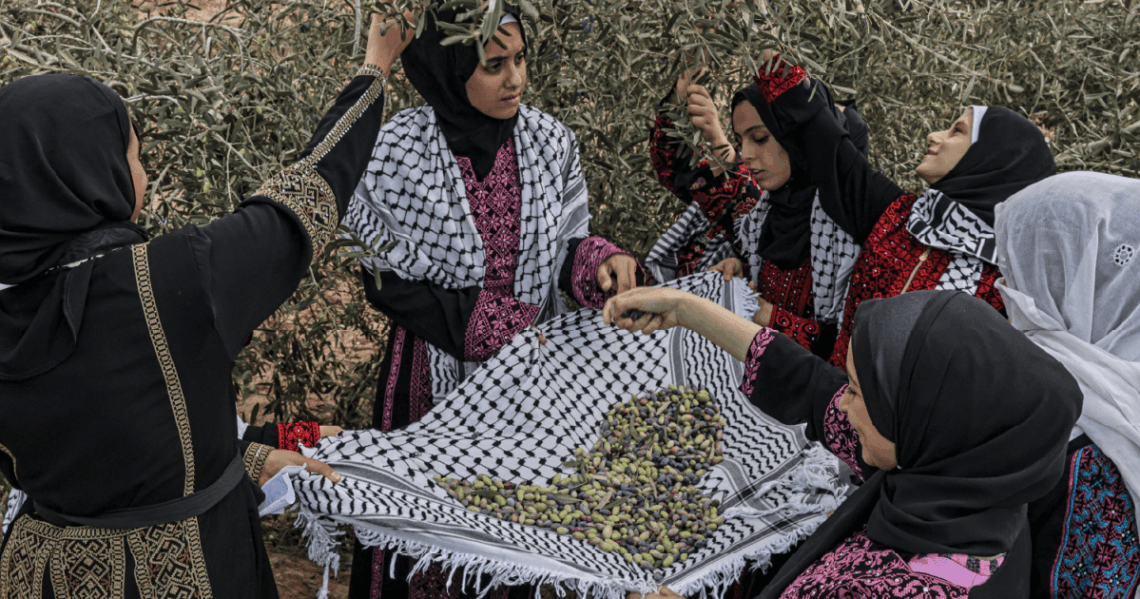Olive harvest season is under way across the occupied West Bank.
In every Palestinian home, there is a “teta” – a grandmother and keeper of family traditions, who shares her recipes for using olives and tells stories of when the whole family gathered to harvest them.
The small green or black fruits are primarily used to produce oil, a staple never missing from a Palestinian dinner table, as well as table olives that accompany many meals.
In this visual explainer, Al Jazeera looks at what makes the olive so special to Palestinian identity and life.
Olive trees have been cultivated across Palestine for thousands of years, serving as a source of livelihood, cultural heritage and resilience.
The olive harvest, known as “mawsim al-zaytoun”, begins in October, with preparations starting in September.
Families ready their tools as the first September rains, talat al-matar, soften the soil, wash the trees and, as many Palestinian proverbs say, bring “barakeh” (blessings) for the harvest and the year ahead.
More than 100,000 families rely on the harvest for their income. It runs through to November and brings together the entire community.
In the years before Israel’s war on Gaza began in October 2023, almost half of all cultivated land across the occupied West Bank and the Gaza Strip was planted with an estimated 10 million olive trees.
Palestinians use olives predominantly for oil, but every part of the tree finds a purpose:
Olive oil – About 90 percent of olives are used to extract oil, with different regions of Palestine producing distinct varieties.
Table olives – Eaten fresh, pickled or seasoned, table olives are a central feature of Palestinian cuisine, festivals and hospitality.
Soap – The city of Nablus is famous for its olive oil soap, which is rich in antioxidants and gentle on the skin.
Wood crafts – Handcrafted olive wood items are made from pruned branches, fallen wood, or old trees that are no longer productive.
Olive trees are among the oldest cultivated trees in the world and can live for centuries while still bearing fruit.
Many olive trees in Palestine are more than 1,000 years old, while a few are believed to be older than 3,000 years.
Olive trees flourish in a Mediterranean climate and, once established, are highly resilient and drought-tolerant.
Olive trees usually alternate between “heavy” years with abundant fruit and “light” years with less olives, a cycle influenced by climate, soil and tree care.
The graphic below illustrates the development of an olive tree, from a fragile young sapling to a fully mature and resilient tree.
Palestine is home to several distinct olive varieties, each with unique flavours, uses and characteristics. Here are the main types:
Nabali (baladi – meaning “local”) – The most common traditional variety, used for both olive oil production and as table olives. These olives are medium to large in size, turning from dark green to black when ripe. Nabali olives produce high-quality olive oil with a rich, fruity flavour.
Souri – Primarily used for producing high-quality oil, Souri olives are smaller, oval-shaped fruit with a firm texture and a slightly bitter, robust flavour. They are often grown in hilly areas with less water and are cultivated across Palestine, Lebanon and the wider Levant region.
Mallisi – Less common than Nabali or Souri, Mallisi olives are prized for their distinctive flavour. They are medium-sized, slightly oval and have a firm texture similar to Souri olives. While primarily used for olive oil production, some trees are also harvested for table olives.
There are also other Palestinian olive varieties, including Nabali muhassan or improved Nabali, which produce visually appealing olives but tend to have lower-quality oil and smaller yields.
Once the olives have been picked and are ready to be turned into oil, they are washed to remove dirt, leaves and stems, and then crushed to release the oil.
Green and black olives are the same fruit, just picked at different stages of ripeness. Early-harvest green olives produce bitter, robust oil which is rich in antioxidants, while late-harvest black olives yield milder, fruitier golden oil. To preserve its flavour and nutrients, olive oil should be stored in a cool, dark place in a tightly sealed dark glass container.
The method of pressing, along with the type and maturity of the olives, directly affects the oil’s quality, antioxidant content and flavour.
Olive oil quality is ranked as follows:
Extra virgin olive oil – The highest-quality olive oil, made from cold-pressed olives with no chemicals and acidity below 0.8 percent. Cold pressing means the olives are crushed and pressed without using heat, preserving their natural flavours, aroma and antioxidants. This method ensures the oil retains the highest levels of nutrients and distinctive taste.
Virgin olive oil – Also cold-pressed, but has a slightly higher acidity of up to 2 percent. Higher acidity indicates more breakdown of the olive fruit, which can happen if the olives are overripe, damaged or stored too long before pressing. Virgin olive oil contains fewer antioxidants and less flavour compared with extra virgin olive oil, though it is still a natural and healthy oil.
Refined olive oil – Chemically processed, often using heat, to remove defects and is often blended with virgin olive oil. It has a mild, neutral flavour and contains few antioxidants compared with virgin or extra virgin olive oils.
Olive pomace oil – The lowest-quality olive oil, extracted from the residual olive paste after the first pressing. The paste is heated to extract the remaining oil. It offers minimal health benefits compared with extra virgin olive oil and has very little flavour or antioxidants.
In 2019, about 177,000 tonnes of olives were pressed, producing 39,600 tonnes of olive oil – roughly 30,000 litres (7,925 gallons), according to the Palestinian Central Bureau of Statistics.
The governorates of Jenin, Tubas and Northern Valleys produced the highest quantity of olive oil at 10,442 tonnes, followed by Tulkarem (6,031 tonnes) and Gaza (5,582 tonnes).
Traditionally a festive time of year, this year’s harvest has once again been overshadowed by a surge in Israeli settler attacks on Palestinian farmers trying to tend their lands.
Since the start of this season, the United Nations Office for the Coordination of Humanitarian Affairs (OCHA) has documented 126 settler attacks across 70 towns and villages, disrupting harvesting activities, injuring approximately 112 Palestinians and vandalising more than 4,000 trees and saplings.
A study published in 2012 by the Applied Research Institute Jerusalem (ARIJ) estimated that since 1967, the Israeli authorities had uprooted 800,000 Palestinian olive trees in the occupied West Bank.
Besides the physical destruction of these olive trees, many Palestinian farmers in the West Bank require Israeli permits to access their land in restricted areas near illegal Israeli settlements. Palestinian farmers are forbidden from accessing much of their land in areas close to settlements, except for a few days a year.
The post Palestine’s olives: A visual guide to the annual harvest and traditions appeared first on Al Jazeera.




